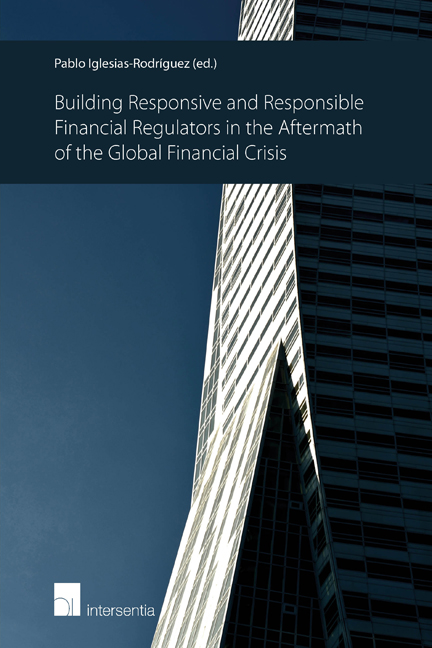Book contents
- Frontmatter
- Preface and acknowledgements
- Foreword
- Contents
- List of contributors
- Responsive-and-responsible financial regulation in the aftermath of the global financial crisis
- Part I THE CONTRIBUTION OF ACCOUNTABILITY, INDEPENDENCE AND ECONOMIC THEORY TO RESPONSIVE-AND-RESPONSIBLE FINANCIAL REGULATION
- Part II POST-CRISIS ARCHITECTURES OF FINANCIAL REGULATION IN THE EUROPEAN UNION, THE UNITED STATES OF AMERICA AND CANADA: ACCOUNTABILITY AND RESPONSIVENESSAND- RESPONSIBILITY
- Part II. 1 THE EUROPEAN UNION
- Governing financial market regulation: a cascade from intergovernmental bank resolution, to prudential regulation, to conduct regulation
- The European Securities and Markets Authority: accountability towards EU institutions and stakeholders
- The role of civil society in EU financial regulation
- Part II. 2 THE UNITED STATES OF AMERICA
- Part II. 3 CANADA
The European Securities and Markets Authority: accountability towards EU institutions and stakeholders
from Part II. 1 - THE EUROPEAN UNION
Published online by Cambridge University Press: 26 November 2017
- Frontmatter
- Preface and acknowledgements
- Foreword
- Contents
- List of contributors
- Responsive-and-responsible financial regulation in the aftermath of the global financial crisis
- Part I THE CONTRIBUTION OF ACCOUNTABILITY, INDEPENDENCE AND ECONOMIC THEORY TO RESPONSIVE-AND-RESPONSIBLE FINANCIAL REGULATION
- Part II POST-CRISIS ARCHITECTURES OF FINANCIAL REGULATION IN THE EUROPEAN UNION, THE UNITED STATES OF AMERICA AND CANADA: ACCOUNTABILITY AND RESPONSIVENESSAND- RESPONSIBILITY
- Part II. 1 THE EUROPEAN UNION
- Governing financial market regulation: a cascade from intergovernmental bank resolution, to prudential regulation, to conduct regulation
- The European Securities and Markets Authority: accountability towards EU institutions and stakeholders
- The role of civil society in EU financial regulation
- Part II. 2 THE UNITED STATES OF AMERICA
- Part II. 3 CANADA
Summary
The paper highlights how the traditional concepts of independence and accountability towards stakeholders apply to the European Securities and Markets Authority (ESMA). ESMA's relationships with national competent authorities, which retain direct supervisory powers with limited exceptions, and the EU Institutions, which are competent for the adoption of legislative and non-legislative regulatory measures, are also considered. ESMA organization and operations are strongly influenced by the position of the new Authority within the EU institutional framework. The European Court of Justice confirmed the legitimacy of the legal basis of ESMA itself and of its powers. ESMA governance still displays some features of a network among national supervisors because its quasi-regulatory functions and supervisory tasks are constrained by limitations directly or indirectly dictated by the Treaties. The analysis shows that tasks conferred to ESMA fall short to match its relatively high accountability, which is on the contrary aligned with international best practices. We suggest therefore some reform proposals that could help streamline regulatory and supervisory functions at EU level, thus allowing ESMA to better exploit its potential while avoiding the risk of excessive centralization of supervisory powers.
INTRODUCTION
This chapter addresses the structure, functions, and powers of the European Securities and Markets Authority (ESMA), one of the three supervisory agencies created in 2010 by the European Union in reaction to the financial crisis. ESMA is certainly a more powerful institution than the Committee of European Securities Regulators (CESR) was in its capacity as a Lamfalussy Level 3 committee, although institutional obstacles and the cautiousness of many Member States, national competent authorities and market players stopped a stronger centralization of regulatory and supervisory powers. Moreover, the governance of the new body still relies on representation of national competent authorities, so that ESMA can also be regarded as a reinforced network among regulators, as well as an instrument for further Europeanization of supervisory functions. Central features of ESMA are its stronger accountability and, more generally, its enhanced relationships with other key players in financial regulation, such as the European Commission, the European Parliament, EU and national authorities, and stakeholders in general. As is the case for any supervisor, the regulatory framework that sets the stage for these relationships is paramount in striking the balance between agency independence, on the one hand, and accountability, on the other.
- Type
- Chapter
- Information
- Building Responsive and Responsible Financial Regulators in the Aftermath of the Global Financial Crisis , pp. 115 - 184Publisher: IntersentiaPrint publication year: 2015



